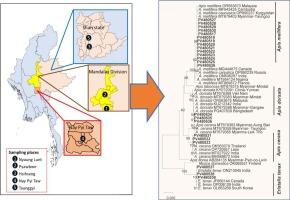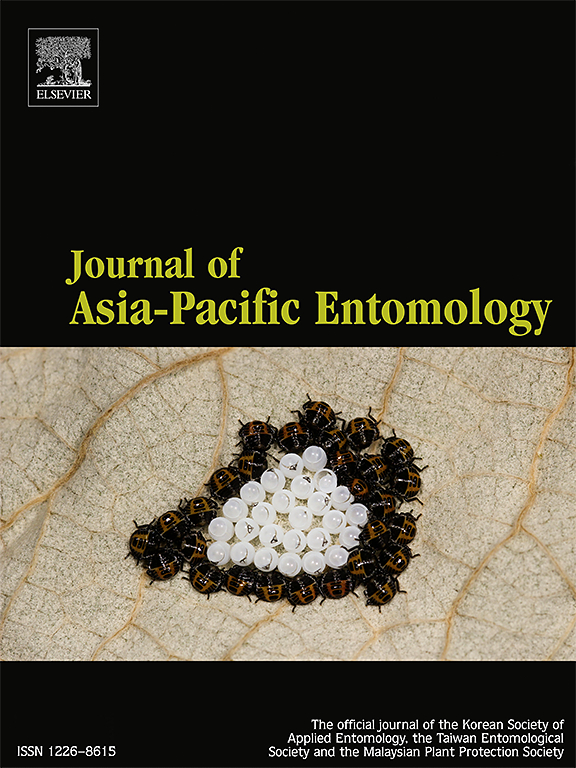Genetic diversity and phylogenetic relationships among western and Asian honey bees, and Eristalis tenax collected in Myanmar
IF 1.3
3区 农林科学
Q3 ENTOMOLOGY
引用次数: 0
Abstract
Honey bees are valuable insects for humans in many ways and continue to benefit people’s livelihoods. Pollinator insects are essential for world food crops production. The aims of this study were to assess the genetic diversity and phylogenetic relationship among the honey bees and to conduct molecular characterisation of pollinator insect species in Myanmar. The Asian honey bee species (Apis cerana and A. dorsata), the European honey bee (A. mellifera) and pollinator insect (Eristalis tenax) collected from selected research stations were studied using partial sequences of the mitochondrial cytochrome c oxidase I (COI) gene. The obtained sequences were analysed using molecular evolutionary genetics and the median-joining haplotype network analysis. The phylogenetic tree divided the entire assemblage of honey bee species collected in Myanmar, including A. mellifera, A. dorsata, and A. cerana, into three major groups, along with those from other countries. The overall haplotype diversity (Hd = 0.9232) indicated a high level of genetic diversity among Myanmar honey bee populations, whereas the nucleotide diversity was relatively low for each population (π = 0.00128–0.03576). A. mellifera showed a substantial variation (P = 0.001) in molecular variants between populations and individuals within them. Two haplotypes were found in A. mellifera and one each for A. cerana, A. dorsata, and E. tenax. This baseline data strengthens our knowledge of the genetic status of indigenous and imported species in the country.

缅甸西部蜜蜂和亚洲蜜蜂的遗传多样性和系统发育关系
蜜蜂在许多方面对人类都是有价值的昆虫,并继续造福于人们的生计。传粉昆虫对世界粮食作物生产至关重要。本研究的目的是评估缅甸蜜蜂的遗传多样性和系统发育关系,并进行传粉昆虫物种的分子特征。利用线粒体细胞色素c氧化酶I (COI)基因的部分序列,对从选定的研究站收集的亚洲蜜蜂(Apis cerana)和A. dorsata)、欧洲蜜蜂(A. mellifera)和传粉昆虫(Eristalis tenax)进行了研究。利用分子进化遗传学和中位连接单倍型网络分析对获得的序列进行了分析。系统发育树将在缅甸收集的蜜蜂物种(包括A. mellifera, A. dorsata和A. cerana)与其他国家的蜜蜂物种一起划分为三个主要群体。总体单倍型多样性(Hd = 0.9232)表明缅甸蜜蜂居群遗传多样性水平较高,而各居群核苷酸多样性相对较低(π = 0.00128 ~ 0.03576)。蜜蜂的分子变异在种群间和个体间存在显著差异(P = 0.001)。在蜜蜂中发现2个单倍型,在中国蜜蜂、dorsata和tenax中各发现1个单倍型。这一基线数据加强了我们对该国本地物种和进口物种遗传状况的了解。
本文章由计算机程序翻译,如有差异,请以英文原文为准。
求助全文
约1分钟内获得全文
求助全文
来源期刊

Journal of Asia-pacific Entomology
Agricultural and Biological Sciences-Insect Science
CiteScore
2.70
自引率
6.70%
发文量
152
审稿时长
69 days
期刊介绍:
The journal publishes original research papers, review articles and short communications in the basic and applied area concerning insects, mites or other arthropods and nematodes of economic importance in agriculture, forestry, industry, human and animal health, and natural resource and environment management, and is the official journal of the Korean Society of Applied Entomology and the Taiwan Entomological Society.
 求助内容:
求助内容: 应助结果提醒方式:
应助结果提醒方式:


